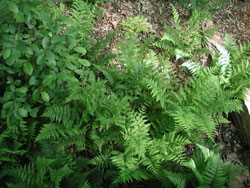Resource Library
Plant of the Week: Lady Fern
The University of Arkansas System Division of Agriculture does not promote, support or recommend plants featured in "Plant of the Week." Please consult your local Extension office for plants suitable for your region.
Plant of the Week
Lady Fern
Latin: Athyrium filix-femina

Ferns have a strong appeal to gardeners. There is something about their seemingly fragile nature and delicate beauty that makes them a welcome addition and subtle foil to their more flamboyant flowery relatives.
Of the hardy kinds lady fern, (Athyrium filix-femina) is among the easiest to grow and most widely adapted.
Lady fern is an ancient species that has been knocking around the globe for at least 60 million years and probably much longer. It's found on all the continents in the northern hemisphere and extends through Central America into the northern parts of South America. She is, indeed, a well-traveled lady. Like most ferns, this species is usually found in cool moist locations along streams and in moist meadows at the edge of a forest.
Lady ferns are deciduous ferns producing three-times divided fronds, usually 2 to 3 feet tall and 4 to 6 inches wide. There are 24 or so short leaflets along the length of the frond with their arrangement in sub-opposite positions. Plants produce a slowly spreading rhizome with numerous fronds produced in tight tufts along its short length.
It's called lady fern because the spores are produced on the backside of the pinnules beneath an eyelid shaped covering (called an indusia) thought to be reminiscent of the eye of the fairer sex.
Because lady fern occurs over such a wide natural range, it's hardly surprising that many variant forms have been discovered and grown. Today, upwards of 20 cultivars of lady fern are available from fern specialists, more than any other fern except the frost tender Boston fern. The Victorian fern craze, a botanical frenzy that occurred between 1845 and 1880, can at least in part be attributed to the efforts of collectors to find new and novel variants of lady fern.
Unlike seed plants, variant forms of ferns will retain their characteristics when grown from spores.
One of the most common lady fern clones offered today is 'Lady in Red,' a vigorous, upright grower with red-brown stems and normal green fronds. Forms with distorted fronds include 'Cristatum' (a form with crested fronds), 'Fieldii' and 'Victoriae' (forms with small, backward turning leaflets crossed like swords) and 'Frizzeliae' (a bizarre form with small, coin-shaped leaflets).
The lady fern has also been a bit naughty, crossing with the closely related Japanese painted fern to produce hybrids such as the gray-leafed 'Ghost' fern.
Lady fern is extremely cold hardy and can be grown from zones 3 through 8. It's ideally suited for any shade garden where it does best in highly organic, well drained and evenly moist soil. Plants have moderate drought tolerance once established. Established clumps can be easily divided in early spring before new growth begins.
By: Gerald Klingaman, retired
Extension Horticulturist - Ornamentals
Extension News - June 5, 2009
The University of Arkansas System Division of Agriculture does not maintain lists of retail outlets where these plants can be purchased. Please check your local nursery or other retail outlets to ask about the availability of these plants for your growing area.